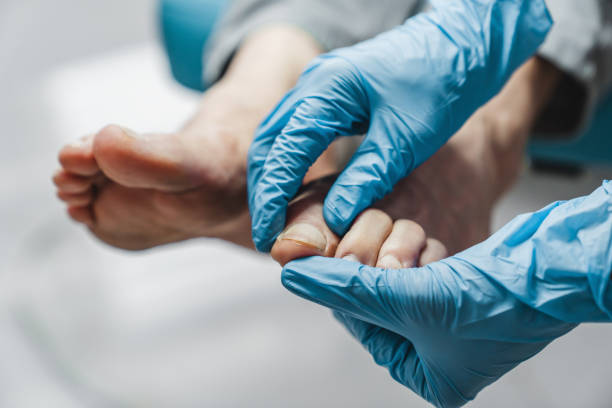
Nails may seem like small, insignificant parts of our body, but they play a significant role in our overall health and well-being. Not only do they protect the sensitive tips of our fingers and toes, but they also serve as indicators of our health status. However, various disorders can affect our nails, causing discomfort and sometimes even serious complications. Fortunately, podiatry offers a specialized approach to treating and preventing common nail disorders, ensuring optimal nail health and overall wellness.
Understanding Common Nail Disorders
Before delving into treatment and prevention methods, it’s essential to understand the most prevalent nail disorders that podiatrists encounter:
- Fungal Infections (Onychomycosis): Fungal infections are perhaps the most common nail disorder, affecting millions of people worldwide. They typically occur when fungi penetrate the nail bed through small cuts or separations between the nail and the nail bed. Symptoms include discoloration, thickening, and brittleness of the nails.
- Ingrown Toenails: This painful condition occurs when the edge of a toenail grows into the surrounding skin, leading to inflammation, redness, and swelling. Ingrown toenails can result from improper nail trimming, tight-fitting shoes, or injury.
- Psoriasis: Psoriasis is a chronic autoimmune condition that can affect the skin and nails. Nail psoriasis often causes pitting, discoloration, and abnormal nail growth, which can significantly impact the appearance and function of the nails.
- Trauma and Injuries: Accidental trauma, such as slamming a finger in a door or dropping a heavy object on the toe, can cause various nail injuries, including bruises, fractures, and lacerations.
- Brittle Nails: Brittle nails are prone to splitting, peeling, and breaking, often due to excessive dryness, frequent exposure to water or harsh chemicals, or underlying health conditions such as thyroid disorders or malnutrition.
Treating Nail Disorders with Podiatry
Podiatrists are medical professionals specializing in the diagnosis, treatment, and prevention of foot and ankle disorders, including those affecting the nails. When it comes to treating nail disorders, a podiatrist High Wycombe employs various techniques tailored to each patient’s specific condition. Some common treatments include:
- Topical Antifungal Medications: For mild to moderate cases of fungal nail infections, podiatrists may prescribe topical antifungal creams or nail lacquers to directly target the fungi and inhibit their growth.
- Oral Antifungal Medications: In more severe cases of fungal infections, oral antifungal medications may be necessary to eradicate the fungi from the inside out. These medications are typically taken for several weeks or months, depending on the severity of the infection.
- Nail Debridement: For thickened or excessively curved nails caused by fungal infections or trauma, podiatrists can perform nail debridement, a procedure that involves trimming and thinning the nails to alleviate discomfort and improve appearance.
- Surgical Interventions: In cases of severe ingrown toenails or chronic nail trauma, surgical interventions such as partial nail avulsion (removal) or nail matrixectomy (removal of the nail root) may be necessary to prevent recurrence and promote healthy nail growth.
- Moisturizing and Protective Measures: Podiatrists may recommend moisturizing creams or ointments to hydrate dry, brittle nails and prevent further damage. Additionally, wearing protective footwear and practicing proper nail hygiene can help prevent nail disorders from occurring or worsening.
Preventing Nail Disorders
While prompt treatment by a podiatrist Guildford is essential for managing nail disorders, taking preventive measures can help reduce the risk of developing them in the first place. Here are some tips for maintaining healthy nails:
- Practice Proper Nail Hygiene: Trim your nails regularly, keeping them short but not too short to prevent ingrown toenails. Use clean, sharp nail clippers, and avoid cutting the nails too close to the skin.
- Wear Appropriate Footwear: Choose shoes that provide adequate room for your toes to move freely and avoid wearing tight-fitting or pointed shoes that can increase the risk of ingrown toenails and other nail disorders.
- Protect Your Nails: Wear gloves when performing tasks that expose your nails to harsh chemicals or excessive moisture, such as washing dishes or cleaning with strong detergents.
- Maintain Overall Foot Health: Keep your feet clean and dry, especially between the toes, to prevent fungal infections. If you notice any signs of a nail disorder, such as discoloration, thickening, or pain, seek prompt evaluation and treatment from a podiatrist.
- Follow a Balanced Diet: Eat a nutritious diet rich in vitamins, minerals, and essential fatty acids to support healthy nail growth and strength. Foods high in biotin, such as eggs, nuts, and leafy greens, may be particularly beneficial for nail health.
Nail disorders can be both uncomfortable and unsightly, but with the help of podiatry, they can be effectively treated and prevented. Whether you’re dealing with a stubborn fungal infection, an ingrown toenail, or brittle nails, a qualified podiatrist can provide personalized care to restore your nail health and improve your overall well-being. By understanding the common causes of nail disorders and implementing preventive measures, you can enjoy healthy, beautiful nails for years to come. Visit www.midlandpodiatry.com.au and learn about nail disorders and treatments you can get to achieve or restore your nail health.






